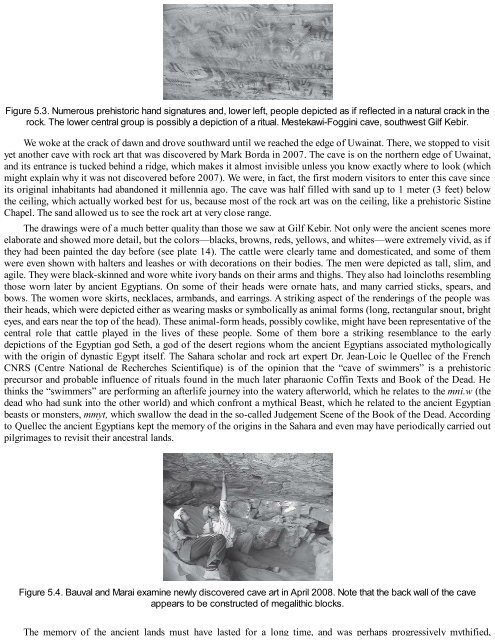Black Genesis: The Prehistoric Origins of Ancient Egypt
Black Genesis: The Prehistoric Origins of Ancient Egypt
Black Genesis: The Prehistoric Origins of Ancient Egypt
Create successful ePaper yourself
Turn your PDF publications into a flip-book with our unique Google optimized e-Paper software.
Figure 5.3. Numerous prehistoric hand signatures and, lower left, people depicted as if reflected in a natural crack in the<br />
rock. <strong>The</strong> lower central group is possibly a depiction <strong>of</strong> a ritual. Mestekawi-Foggini cave, southwest Gilf Kebir.<br />
We woke at the crack <strong>of</strong> dawn and drove southward until we reached the edge <strong>of</strong> Uwainat. <strong>The</strong>re, we stopped to visit<br />
yet another cave with rock art that was discovered by Mark Borda in 2007. <strong>The</strong> cave is on the northern edge <strong>of</strong> Uwainat,<br />
and its entrance is tucked behind a ridge, which makes it almost invisible unless you know exactly where to look (which<br />
might explain why it was not discovered before 2007). We were, in fact, the first modern visitors to enter this cave since<br />
its original inhabitants had abandoned it millennia ago. <strong>The</strong> cave was half filled with sand up to 1 meter (3 feet) below<br />
the ceiling, which actually worked best for us, because most <strong>of</strong> the rock art was on the ceiling, like a prehistoric Sistine<br />
Chapel. <strong>The</strong> sand allowed us to see the rock art at very close range.<br />
<strong>The</strong> drawings were <strong>of</strong> a much better quality than those we saw at Gilf Kebir. Not only were the ancient scenes more<br />
elaborate and showed more detail, but the colors—blacks, browns, reds, yellows, and whites—were extremely vivid, as if<br />
they had been painted the day before (see plate 14). <strong>The</strong> cattle were clearly tame and domesticated, and some <strong>of</strong> them<br />
were even shown with halters and leashes or with decorations on their bodies. <strong>The</strong> men were depicted as tall, slim, and<br />
agile. <strong>The</strong>y were black-skinned and wore white ivory bands on their arms and thighs. <strong>The</strong>y also had loincloths resembling<br />
those worn later by ancient <strong>Egypt</strong>ians. On some <strong>of</strong> their heads were ornate hats, and many carried sticks, spears, and<br />
bows. <strong>The</strong> women wore skirts, necklaces, armbands, and earrings. A striking aspect <strong>of</strong> the renderings <strong>of</strong> the people was<br />
their heads, which were depicted either as wearing masks or symbolically as animal forms (long, rectangular snout, bright<br />
eyes, and ears near the top <strong>of</strong> the head). <strong>The</strong>se animal-form heads, possibly cowlike, might have been representative <strong>of</strong> the<br />
central role that cattle played in the lives <strong>of</strong> these people. Some <strong>of</strong> them bore a striking resemblance to the early<br />
depictions <strong>of</strong> the <strong>Egypt</strong>ian god Seth, a god <strong>of</strong> the desert regions whom the ancient <strong>Egypt</strong>ians associated mythologically<br />
with the origin <strong>of</strong> dynastic <strong>Egypt</strong> itself. <strong>The</strong> Sahara scholar and rock art expert Dr. Jean-Loic le Quellec <strong>of</strong> the French<br />
CNRS (Centre National de Recherches Scientifique) is <strong>of</strong> the opinion that the “cave <strong>of</strong> swimmers” is a prehistoric<br />
precursor and probable influence <strong>of</strong> rituals found in the much later pharaonic C<strong>of</strong>fin Texts and Book <strong>of</strong> the Dead. He<br />
thinks the “swimmers” are performing an afterlife journey into the watery afterworld, which he relates to the mni.w (the<br />
dead who had sunk into the other world) and which confront a mythical Beast, which he related to the ancient <strong>Egypt</strong>ian<br />
beasts or monsters, mmyt, which swallow the dead in the so-called Judgement Scene <strong>of</strong> the Book <strong>of</strong> the Dead. According<br />
to Quellec the ancient <strong>Egypt</strong>ians kept the memory <strong>of</strong> the origins in the Sahara and even may have periodically carried out<br />
pilgrimages to revisit their ancestral lands.<br />
Figure 5.4. Bauval and Marai examine newly discovered cave art in April 2008. Note that the back wall <strong>of</strong> the cave<br />
appears to be constructed <strong>of</strong> megalithic blocks.<br />
<strong>The</strong> memory <strong>of</strong> the ancient lands must have lasted for a long time, and was perhaps progressively mythified,


